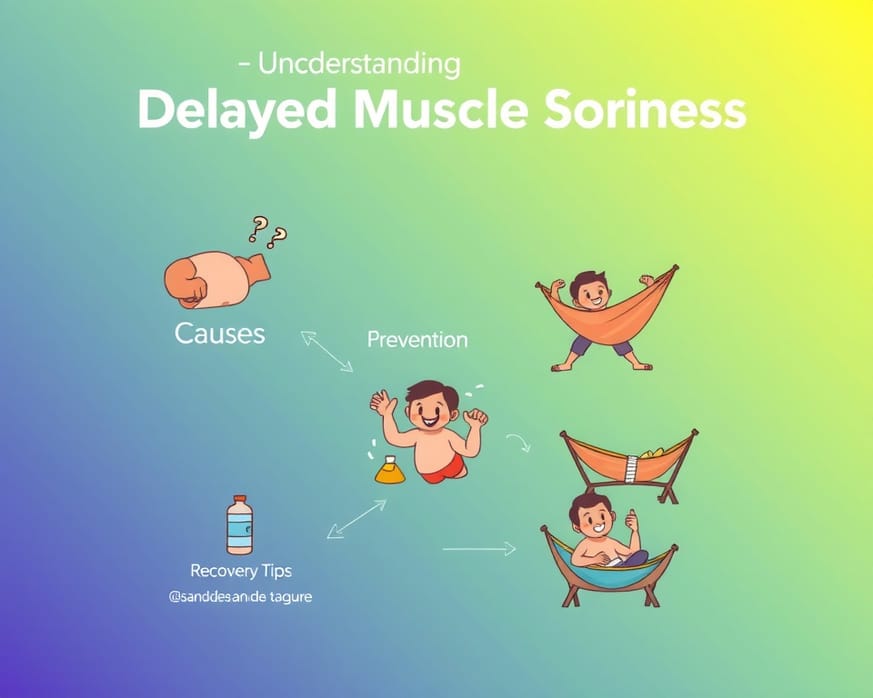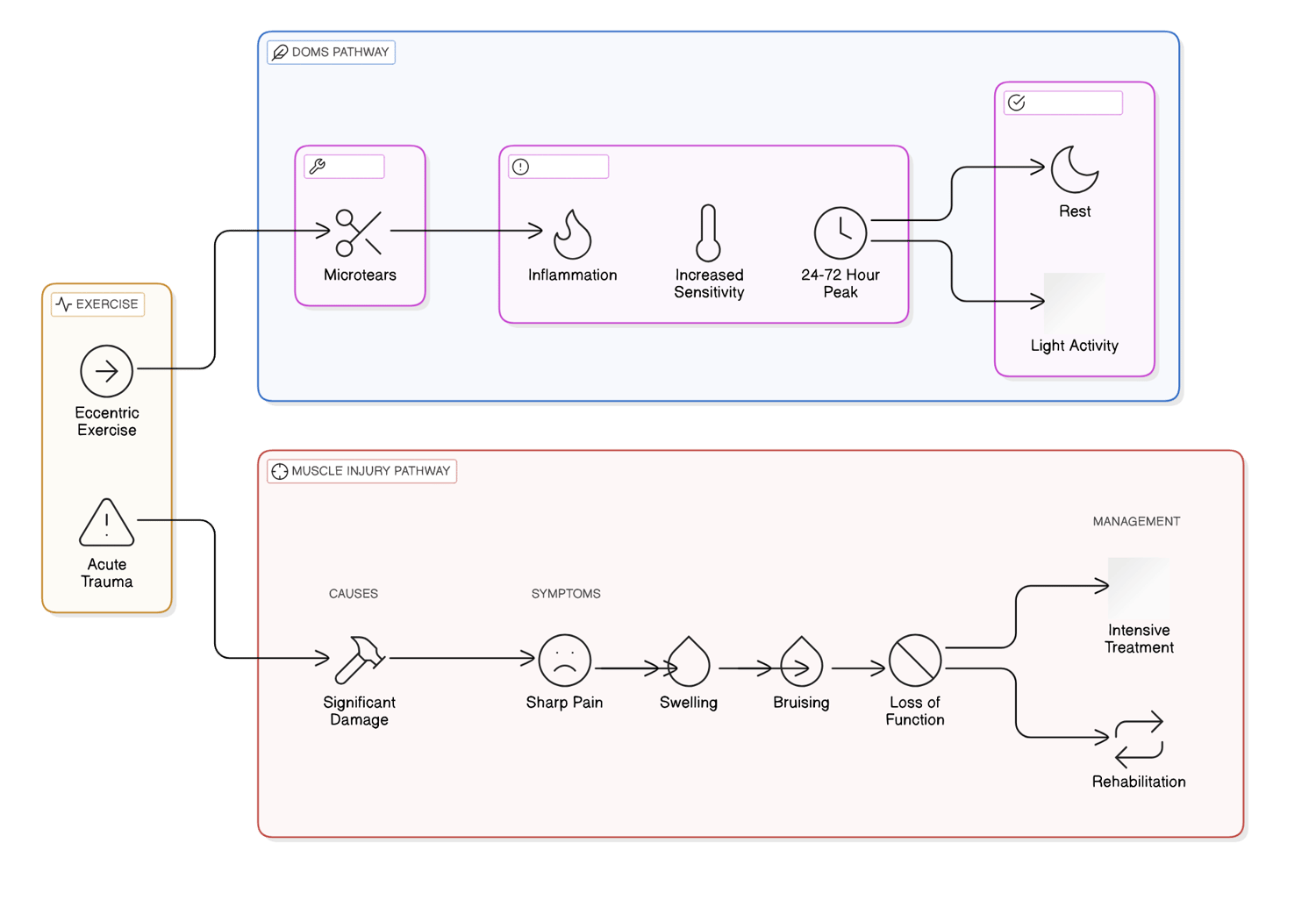Summary
This article delves into the intricacies of Delayed Onset Muscle Soreness (DOMS), exploring its causes, prevention strategies, and effective recovery tips. As someone who has navigated the ups and downs of post-workout soreness myself, I find these insights invaluable for anyone looking to optimize their fitness journey. Key Points:
- Emerging research suggests that exosomes play a crucial role in muscle repair and inflammation reduction after exercise, presenting new avenues for recovery beyond traditional methods.
- Personalized management of Delayed Onset Muscle Soreness (DOMS) based on individual genetics and exercise profiles can significantly enhance recovery strategies.
- The gut microbiome`s influence on inflammation indicates that dietary modifications might aid in muscle recovery and potentially lessen DOMS severity.
Ever Wonder Why Your Muscles Ache After a Workout?
My First Experience with Delayed Onset Muscle Soreness (DOMS): A Fitness Trainer`s Story
By day two, navigating stairs was like scaling Everest. Each step sent shockwaves through my thighs—“Is this even normal?” I messaged my mentor in a panic. His reply? “Welcome to DOMS!” Great—a badge of honor for overdoing it.
I’d heard about delayed onset muscle soreness before but experiencing it was another story entirely. 72 hours post-workout? My body screamed in protest with every movement. Doubts crept in: “Will this affect my clients? Am I cut out for this job?” It felt like an emotional rollercoaster—excitement morphed into frustration as I grappled with pain and self-doubt. Honestly, at that moment, all I could think was how unprepared I really was for this journey ahead—it wasn’t just physical; it was mental too—and we both stood there stunned by the realization.
| Aspect | Delayed Onset Muscle Soreness (DOMS) | Acute Muscle Soreness | Muscle Fatigue | Muscle Strain |
|---|---|---|---|---|
| Definition | Pain and stiffness in muscles that occurs after intense exercise, usually peaking 24-72 hours post-workout. | Immediate pain felt during or right after exercise due to lactic acid buildup. | General feeling of tiredness and reduced performance in muscles after prolonged activity. | Injury to a muscle or tendon caused by overstretching or excessive force. |
| Causes | Eccentric contractions, unfamiliar physical activities, high-intensity workouts. | High intensity or prolonged exertion leading to metabolic byproducts like lactic acid. | Extended periods of exercise without rest, inadequate recovery methods. | Overexertion, improper form during lifting, sudden increase in activity level. |
| Symptoms | Soreness, stiffness, swelling in the affected muscles; may affect mobility temporarily. | Sharp pain during activity that subsides shortly after stopping; discomfort may linger briefly post-exercise. | General weakness, tiredness of the muscles; may lead to poor performance in subsequent workouts. | Localized pain at the injury site; swelling and sometimes bruising can occur. |
| Prevention Strategies | Gradual progression in workout intensity, proper warm-up and cool-down routines. | Adequate hydration and pacing during workouts to minimize lactic acid buildup. | Regular rest days incorporated into training schedules; cross-training for balanced muscle use. | Using proper technique when exercising; warming up thoroughly before intense activities. |
| Recovery Tips | Active recovery (light exercises), foam rolling/massage therapy, hydration & nutrition rich in protein & antioxidants. | Resting with gentle movement if necessary; staying hydrated helps flush out toxins quickly. | Focus on hydration and nutrient replenishment post-exercise. Gentle stretching can aid recovery. | Ice application for acute injuries followed by compression/rest as needed. Consult a professional for severe strains. |
The Turning Point: From DOMS Despair to Understanding
By day three, when the soreness peaked and I dreaded even lifting a water bottle, I felt the weight of their expectations pressing down on me. We were all in this together—yet here I was, barely able to demonstrate a proper squat without wincing. Some clients exchanged worried looks; others started flipping through fitness articles on their phones mid-session. The energy shifted—conversations about workout routines turned into murmurs of concern.
“Maybe we should take it easy,” someone suggested cautiously. It struck me then: DOMS wasn’t just my personal battle anymore; it had seeped into our training environment. We were all grappling with uncertainty—some ready to push through while others hesitated at the thought of more pain. And just like that, we shared an unspoken bond over our collective discomfort—a strange camaraderie forged in soreness and self-doubt.
How We Helped a Client Overcome Severe DOMS
As we discussed options—heat therapy versus active recovery—uncertainty hung in the air. Some believed rest was key, while others argued that moving might help. Sarah listened intently but looked unconvinced. “What if this just doesn’t go away?” she asked quietly. The room fell silent; no one had a definitive answer. The tension remained palpable as we deliberated what steps to take next—still unsure if any approach would truly alleviate her suffering.

 Free Images
Free ImagesFAQs: Addressing Common Concerns about Delayed Muscle Soreness
Many individuals overlook that this soreness primarily stems from microscopic damage to muscle fibers. After intense workouts—especially those involving eccentric movements (like the lowering phase of a squat)—your muscles experience tiny tears. This can sound alarming, but it’s actually a normal part of building strength. The pain typically peaks 24-72 hours post-exercise, which can lead some to feel concerned about their fitness journey.
Another frequently asked question is: "How can I prevent DOMS?" 💡 A lot of folks miss out on the importance of gradually increasing training intensity and volume. Think of it like climbing a hill; you wouldn't sprint up without preparing first! Incorporating proper warm-up routines and cool-down stretches not only helps your muscles get ready for action but also aids in recovery afterward.
Lastly, many wonder whether light exercise during recovery is beneficial. The answer is yes! Engaging in gentle activities like walking or light aerobic exercises can boost blood flow and help alleviate soreness without making things worse. So next time you're feeling sore, remember that movement might be just what you need!
In summary, understanding these aspects can really empower you on your fitness journey—so don’t let DOMS discourage you! 🎉
Is DOMS a Sign of a Good Workout? Debunking the Myths
DOMS vs. Muscle Injury: How to Tell the Difference?
Practical Strategies for Preventing and Relieving DOMS
Delayed Onset Muscle Soreness (DOMS) can be a frustrating experience for anyone who has pushed their physical limits, especially after intense or unfamiliar workouts. Having dealt with DOMS myself after an ambitious leg day, I understand how it can hinder your motivation to stay active. Fortunately, there are practical strategies you can implement to minimize its effects and promote faster recovery. Here’s a step-by-step guide that will help you on your fitness journey.
### Step 1: Warm-Up Properly
Start each workout with a dynamic warm-up routine that lasts at least 10-15 minutes. This could include movements like leg swings, arm circles, or light jogging to increase blood flow to your muscles. (Pro tip: I personally love doing some jumping jacks; they really get my heart rate up!)
### Step 2: Gradually Increase Intensity
When beginning a new exercise regimen or returning after a break, gradually ramp up the intensity of your workouts. Aim for a progressive overload approach—this means slowly increasing weights or reps over weeks rather than going all-out from day one.
### Step 3: Active Recovery Post-Workout
After exercising, engage in light aerobic activities such as walking or cycling for about 15-20 minutes. This helps maintain circulation without placing additional stress on your muscles. Remember, the goal here is gentle movement!
### Step 4: Utilize Foam Rollers and Massage Therapy
Incorporate foam rolling into your post-workout routine to alleviate tightness and improve blood flow in sore areas. Spend extra time on particularly tense spots but remember not to roll over painful knots aggressively! (I usually set aside about five minutes post-exercise just for this.)
### Step 5: Focus on Nutrition and Hydration
Ensure you're consuming adequate protein within two hours of finishing your workout; aim for around 20 grams depending on body weight and activity level. Also, stay hydrated throughout the day—this supports overall muscle function during recovery phases.
### Final Thoughts & Advanced Tips
If you’re looking to take it even further, consider scheduling regular sports massages every month—they can work wonders in preventing chronic soreness by addressing underlying muscle tension before it escalates into DOMS. Additionally, if you're still feeling sore after implementing these strategies, think about incorporating more rest days into your training schedule—your body needs time to recover!
By following these steps consistently, you'll not only mitigate the severity of DOMS but also enhance your overall performance and enjoyment of fitness activities!

What’s Next in DOMS Research? The Future of Muscle Recovery
Conquering DOMS: A Summary of Prevention, Recovery, and Future Directions
Delayed Onset Muscle Soreness (DOMS) is a common experience for many athletes and fitness enthusiasts, primarily resulting from microtrauma to muscle fibers during eccentric contractions. This damage initiates an inflammatory response that manifests as soreness, typically peaking between 24 to 72 hours post-exercise. To effectively prevent DOMS, it’s crucial to adopt strategies such as gradually increasing training intensity and incorporating proper warm-up routines that promote blood flow and flexibility.
Recovery plays an equally vital role in managing DOMS symptoms. Techniques like active recovery, adequate hydration, and ensuring sufficient protein intake can significantly aid in muscle repair. As we look toward the future of fitness training and recovery methods, research should delve deeper into the molecular mechanisms behind muscle adaptation. Exploring innovative modalities such as cryotherapy or foam rolling may provide new avenues to optimize athletic performance while minimizing soreness.
This trend shows no signs of waning; thus, it's essential for athletes to continuously adapt their training regimens based on emerging insights into DOMS management. By staying informed about these advancements and personalizing approaches to prevention and recovery, individuals can enhance their performance while reducing discomfort associated with exercise-induced muscle damage.
Now is the time to take action—experiment with these strategies and discover what works best for you!
Reference Articles
DOMS: Causes, recovery, and prevention
DOMS is a type of muscle pain that peaks 1–2 days after strenuous physical activity. Typically, it resolves within 4 days.
Source: MedicalNewsTodayDelayed Onset Muscle Soreness (DOMS)
Stretching is very helpful to your recovery. To keep your muscles moving, try gentle yoga or some low- to moderate-intensity walking, cycling, or swimming.
Source: HealthlineDelayed onset muscle soreness : treatment strategies and ...
Exercise is the most effective means of alleviating pain during DOMS, however the analgesic effect is also temporary. Athletes who must train on a daily basis ...
Delayed Onset Muscle Soreness (DOMS)
While origins of the soreness and accompanying symptoms are complex, it is well-established that many types of physical activity can cause delayed soreness.
Muscle Soreness After a Workout: Can It Be Prevented?
Typically, delayed onset muscle soreness begins about 12 to 24 hours post-exercise and can peak anywhere between one to three days.
Source: Houston MethodistDelayed Onset Muscle Soreness
This soreness is thought to result from temporary muscle damage and inflammation, commonly triggered by eccentric exercises. Implementing recovery strategies ...
Source: PhysiopediaRunner's World: What is Delayed Onset Muscle Soreness ...
Delayed onset muscle soreness can be improved by drinking water and performing new movements with low volume, weight and intensity, ...
Source: Cedars-SinaiMuscle Soreness & DOMS: How to Prevent & Treat ...
Delayed Onset Muscle Soreness (DOMS) is typically caused by micro-tears in your muscles, which is common during exercise - especially eccentric exercises.
Source: NASM


 ALL
ALL Sports Data Science
Sports Data Science
Related Discussions